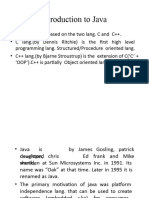0% found this document useful (0 votes)
4 views4 pagesJava Chapter1 Notes
it describes chapter 1 in details with example
Uploaded by
Madhu GopinathCopyright
© © All Rights Reserved
We take content rights seriously. If you suspect this is your content, claim it here.
Available Formats
Download as DOCX, PDF, TXT or read online on Scribd
0% found this document useful (0 votes)
4 views4 pagesJava Chapter1 Notes
it describes chapter 1 in details with example
Uploaded by
Madhu GopinathCopyright
© © All Rights Reserved
We take content rights seriously. If you suspect this is your content, claim it here.
Available Formats
Download as DOCX, PDF, TXT or read online on Scribd
/ 4














































































